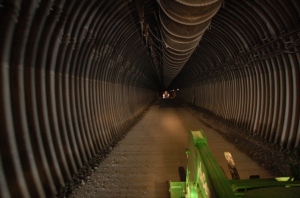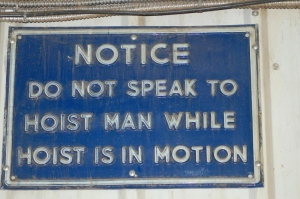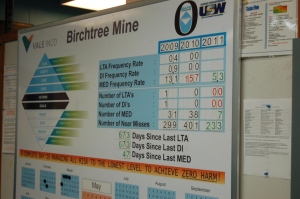

https://soundingsjohnbarker.wordpress.com/) debuted as a WordPress blog two years ago today with a small post headlined “Labour history: Mine-Mill v. Steel” (https://soundingsjohnbarker.wordpress.com/2014/09/03/labour-history-mine-mill-v-steel/) on September 3, 2014 about Mick Lowe’s The Raids, a 295-page fictionalized work centred on the epic battle in Sudbury in the late 1950s and early 1960s in relation to the Cold War, international politics, McCarthyism, Communism, and the inter-union rivalry between the United Steel Workers of America (USWA) and the International Union of Mine, Mill & Smelter Workers Local 598, which had just been published that May by Robin Philpot of Baraka Books in Montreal. Here in Thompson there is a still partially untold story of that same inter-union rivalry between the Union of Mine, Mill & Smelter Workers and United Steelworkers of America between 1960 and 1962. Mine-Mill was the first bargaining agent here in Thompson when Inco workers unionized and had negotiated a contract with Inco that ran through 1964. But the USW was certified by the Manitoba Labour Board as the bargaining agent for Inco employees in Thompson on May 31, 1962. Because the USW itself went on to merge five years later with the United States section of the International Union of Mine, Mill & Smelter Workers in Tucson, Arizona in January 1967, a lot of that nastiness has been papered over, at least publicly.
There was also a post that day headlined “Black Death: Not so bad?” (https://soundingsjohnbarker.wordpress.com/2014/09/03/black-death-not-so-bad/) which went onto explain a new study in PLOS ONE, an international peer-reviewed journal, authored by University of South Carolina anthropologist Sharon DeWitte, which suggested that people who survived the medieval plague, commonly known then as the Black Death, lived significantly longer and were healthier than people who lived before the epidemic struck in 1347. The Black Death killed tens of millions of people, an estimated 30 to 50 per cent of the European population, over just four years between 1347 and 1351, which, it turns out, may not have been such a bad thing after all.
Finally, on Sept. 3, 2014, soundingsjohnbarker had a third posting headlined “A bigger picture,” (https://soundingsjohnbarker.wordpress.com/2014/09/03/a-bigger-picture/) which focused on Samaritan’s Purse’s “Operation Christmas Child,” which was started in 1990. By 1993, it had grown to the point it was adopted by Samaritan’s Purse, a Christian organization founded by Dr. Bob Pierce in 1970 and now run by Franklin Graham, son of 97-year-old Asheville, North Carolina evangelist Billy Graham. While “Operation Christmas Child” has its share of supporters and critics with meritorious arguments on both sides for and against its “shoebox” gifts collected and distributed in more than 130 countries worldwide each Christmas [each shoebox is filled with hygiene items, school supplies, toys, and candy. Operation Christmas Child then works with local churches to put on age-appropriate presentations of the gospel at the events where the shoeboxes are distributed], Samaritan’s Purse is about much more than Operation Christmas Child, whatever your views might be on that, I pointed out. In the midst of the deadliest Ebola viral hemorrhagic fever outbreak recorded in West Africa since the disease was discovered in 1976, Samaritan Purse’s Ebola care centre on the outskirts of the Liberian capital of Monrovia was right on the front lines. Dr. Kent Brantly, the medical director of the centre, contracted Ebola and was medically evacuated to Emory University Hospital in Atlanta, the first patient ever medically evacuated to the United States for Ebola treatment, where he was given ZMapp, an experimental drug treatment produced by U.S.-based Mapp Biopharmaceutical, while Nancy Writebol, who was with Serving in Mission, (SIM), which runs the hospital where Samaritan’s Purse has the Ebola care centre, was also medically evacuated to Emory University Hospital and treated with ZMapp. Both Brantly and Writebol survived their brush with death Ebola experiences and returned to Liberia.
So that was Day 1 for soundingsjohnbarker on Sept. 3, 2014. And in some ways it set the tone for the 226 posts that have followed since over the last two years. Some of them tell Thompson stories but many don’t. Some (OK, many) are offbeat and the range of topics that has struck my fancy to write about has been eclectic, if not downright eccentric at times. I explained some of my thinking behind how I choose what to write about in a blog post March 7 headlined “Tipping points and blogging by the numbers” (https://soundingsjohnbarker.wordpress.com/2016/03/07/tipping-points-and-blogging-by-the-numbers/) where I noted, “Write local if you want some big numbers on a given day. While I do from time to time, if some local issue or story interests me in an unusual way, I stay away from that kind of writing for the most part. For one thing, those kind of stories, I find, have little staying power, with three or four rare local exceptions (an unsolved murder story; a story about Dr. Alan Rich’s retirement and local lawyer Alain Huberdeau’s appointment to the provincial court bench; and several Vale stories come to mind). But most of them are one or two day wonders. It’s the more eccentric pieces on other places and even times that have a deeper and wider audience in the long run. Fortunately, I prefer to write on more eclectic things these days without any particular regard for geography or subject matter if the topic strikes my interest. Thompson city council may well make decisions that affect me in myriad ways, not the least of which is in the pocketbook as a local taxpayer, but even that can’t remove the glaze from my eyes long enough to write much about local municipal politics, although our water bills are tempting me to make an exception. But reading newspaper accounts of such goings on is usually painful enough. Mind you, I realize what strikes my fancy to write about when I don’t write local, is not for everyone, and I have no doubt that I’ve created some eye glazing of my own especially when I write on eschatology or some other arcane to some of my local readers religious topic.”
That’s not to say I’ve lost my interest in local affairs. I live here after all. But I don’t have the inclination, or time even if I had, to write about all of them. So, pretty much like everyone else in Thompson, I rely on the local media, including the Thompson Citizen and Nickel Belt News, CBC Radio’s North Country, Arctic Radio’s thompsononline.ca and Shaw TV to keep me informed with occasional stories about Vale’s proposed Thompson Foot Wall Deep Project, at the north end of Thompson Mine, previously known as Thompson (1D), and what the chances of the 11 million tonnes of nickel mineralization, which form a deep, north plunging continuation of the Thompson deposit, have of being developed into a new mine that will sustain the Thompson operation for up to 15 years when nickel is selling on the London Metal Exchange (LME) for US$4.5269/lb, with the refinery and smelter, which opened March 25, 1961, set to close sometime in 2018, resulting in lost jobs – don’t kid yourself and think otherwise – as more than 30 per cent of Vale’s production employees in Thompson work in the smelter and refinery.
Take away nickel mining, which isn’t destined fortunately to happen for at least several decades yet in even the most pessimistic scenario, and there’s not much reason for Thompson, at least as we have all come to know it, to exist, all mindless happy talk from politicians, newspaper publishers and other spin doctors aside. Mind you, I have admittedly been a tad critical of newspaper publishers in this space before, writing on Sept. 14, 2014: “In the old days, publishers and newspaper owners would from time to time ‘kill’ a writer’s column before publication. Despite their ballyhoo and blather about freedom of the press, publishers and newspaper proprietors are almost universally in my long experience with them a timid lot, if not outright moral cowards at times, always afraid of offending someone.”(https://soundingsjohnbarker.wordpress.com/2014/09/11/retroactively-spiked-the-post-publication-killing-of-msgr-charles-popes-blog-post-on-new-york-citys-st-patricks-day-parade/).
But if you think being a regional hub for Northern Manitoba, or tourism, or even both, is going to give Thompson a new raison d’etre for continued existence at its current size and state in a somehow magically more diversified local economy sans nickel mining some day in the near-to-mid future, I’m afraid you’ve been drinking too much of the Thompson Economic Diversification Working Group (TEDWG) Kool-Aid.
I’m a bit of a contrarian when it comes to the local good news peddlers of all stripes. So it’s perhaps best for everyone’s peace of mind, mine included, if I stick these days to writing mainly about the faraway and eclectic. Bad news prophets have a short best-before date at home.
And besides there is something just plain fun about writing about the weird and whacky. It’s a good antidote to taking either yourself, or life for that matter, too seriously. Hence I’m just as incorrigible when it comes to posting stories or links from others about the offbeat and odd on Facebook, as I am about my own blog post writing, I must confess. “The internet has been aflame this summer with predictions the Antichrist was coming Aug. 30,” I mentioned in a Facebook posting Aug, 31, noting I had forgotten all about it until the next day. “Me bad,” I wrote. When my old friend from Iqaluit Michèle LeTourneau found herself among those who couldn’t resist joining the thread to comment, she observed “OK. I think I just officially outed myself as a weird nut that posts really weird things on Facebook. Maybe I am. Maybe I’m not.” I reassured her by replying, “I think I could give you a bit of competition for the ‘weird nut Facebook poster’ title, Michèle!”
Locally, the Thompson Citizen was moved to editorialize Aug. 31 that “Northern Manitoba’s summer of woe turned [a] deeper shade of blue with the announcement Aug. 22 that Tolko was shutting down its operations in The Pas.”
Tolko Industries said they were going to pull the plug Dec. 2 on their heavy-duty kraft paper and lumber mill in The Pas after 19 years, leaving all 332 employees unemployed. The mill in The Pas has been a money-loser for years. It was conceived by the Progressive Conservative provincial government of premier Duff Roblin in 1966.
Less than a month before Tolko pulled the plug on its mill in The Pas, OmniTRAX, the Denver-based short line railroad, which owns the Port of Churchill, announced on July 25 it would be laying off or not re-hiring about 90 port workers, as it was cancelling the 2016 grain shipping season. OmniTRAX bought most of Northern Manitoba’s rail track from The Pas to Churchill in 1997 from CN for $11 million. OmniTRAX took over the related Port of Churchill, which opened in 1929, when it acquired it from Canada Ports Corporation, for a token $10 soon after buying the rail line. The Port of Churchill has the largest fuel terminal in the Arctic and is North America’s only deep water Arctic seaport that offers a gateway between North America and Mexico, South America, Europe and the Middle East. OmniTRAX created Hudson Bay Railway in 1997, the same year it took over operation of the Port of Churchill. It operates 820 kilometres of track in Manitoba between The Pas and Churchill.
At the time the cancellation was announced, OmniTRAX did not have a single committed grain shipping contract. Normally, the Port of Churchill has a 14-week shipping season from July 15 to Oct. 31. When the Canadian Wheat Board lost its grain monopoly, creating a new grain market several years ago, and was renamed G3 Canada Ltd. by its new owners, the newly-minted G3 Canada Ltd. began building a network of grain elevators, terminals and vessels that bypasses Churchill and uses the Great Lakes, St. Lawrence River and West Coast to move grain to foreign markets. Surprise.
While OmniTRAX accepted a letter of intent last December from Mathias Colomb First Nation, Tataskweyak Cree Nation and the War Lake First Nation to buy its rail assets in Manitoba, along with the Port of Churchill, the deal has not been completed to date, and its future looks murky to non-existent. Rail freight shipments measured by frequency along the Bayline have been cut in half by OmniTRAX this summer.
“Government announces more grant money to develop tourism during visit to Churchill” headlined the Nickel Belt News in an unbylined front page story Sept. 2. Don’t get me wrong. I love Beluga whales and polar bears. I’ve seen both visiting Churchill (known as Kuugjuaq in Inuit.) And guess what? While Beluga whales and polar bears will support some local tourism and related businesses, it’s still not enough to make for a local sustainable economy of any scale in the community of less than 800 permanent residents now along our Hudson Bay coast.
That’s about as likely to happen as calling itself the “Wolf Capital of the World” is going make a game-changing difference to Thompson’s economic future. A difference, sure. Great. But don’t bet Northern Manitoba’s future on tourism. We’re still either a resource-based economy or no economy to speak of. If it’s any comfort that remains largely true for most of our provinces and territories and Canada as a whole. Sure there’s the capital cities and a few other kinda largish provincial cities – Victoria, Vancouver, Edmonton, Calgary, Regina, Winnipeg, Toronto, Ottawa, Montréal, Québec City, Moncton, Saint John, Halifax and St. John’s (this is a very generous reading BTW) – and even a few more genuine high-tech areas such as Gatineau, Québec and Kanata, Ontario on either side of Ottawa, along with Kitchener, Ontario and elsewhere in the Regional Municipality of Waterloo, all of which are exceptions to the hewers of wood and drawers of water reality, but the exceptions are few and far between.
Oops … did I say that out loud? Me bad.
Kool-Aid anyone?
I may need to quench my thirst unless I intend to pen my next post on UFOs, eschatology or perhaps some virulent disease, preferably a safe distance from Thompson.
You can also follow me on Twitter at: https://twitter.com/jwbarker22
55.743353
-97.846158

 The brothers aren’t getting any younger. Pete Zaworonok is 77. His younger brother, Raymond is 72. Neither are in the best of health these days. So retirement looms, with Pete planning to relocate permanently back to his longtime home near Nelson, British Columbia, while Raymond’s home is in Calgary. Until recently, the brothers would often takes turns commuting back to their Alberta and British Columbia homes for months at a time, while the other brother remained in Thompson minding the store, Crazy Petes, their legendary eclectic small-town hardware-like store, at the corner of Hayes Road and Seal Road, with one of this, and two of that. On rare occasions, I’d come into the store while the brothers were together during a brief overlap.
The brothers aren’t getting any younger. Pete Zaworonok is 77. His younger brother, Raymond is 72. Neither are in the best of health these days. So retirement looms, with Pete planning to relocate permanently back to his longtime home near Nelson, British Columbia, while Raymond’s home is in Calgary. Until recently, the brothers would often takes turns commuting back to their Alberta and British Columbia homes for months at a time, while the other brother remained in Thompson minding the store, Crazy Petes, their legendary eclectic small-town hardware-like store, at the corner of Hayes Road and Seal Road, with one of this, and two of that. On rare occasions, I’d come into the store while the brothers were together during a brief overlap.



















